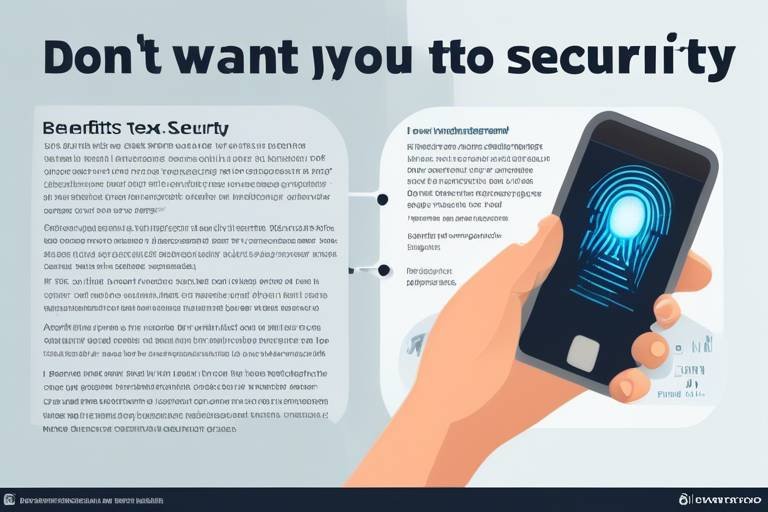Human Error - The Weak Link in Cybersecurity
In today's digital age, where technology is deeply woven into the fabric of our daily lives, the importance of cybersecurity cannot be overstated. Yet, amidst all the advanced security measures and sophisticated technologies, one glaring vulnerability remains: human error. It’s astonishing to think that the most secure systems can be compromised not by complex hacking techniques, but by simple mistakes made by individuals. This article explores how human error significantly impacts cybersecurity, examining the causes, consequences, and strategies to mitigate risks associated with human mistakes in digital security environments.
Understanding the different types of human errors is crucial in cybersecurity. Human error can manifest in various forms, from cognitive biases that cloud judgment to decision-making flaws that lead to poor choices. For instance, when individuals are overwhelmed with information, they may overlook critical warnings or fail to recognize suspicious activity. This section delves into these cognitive biases and decision-making flaws, illustrating how they contribute to vulnerabilities in information systems. It's almost like trying to navigate a maze blindfolded; without the right awareness and training, even the most cautious individuals can stumble into traps that compromise security.
Several frequent mistakes made by individuals can significantly jeopardize cybersecurity. These include susceptibility to phishing, poor password practices, and improper handling of sensitive information. Each of these errors can lead to significant security breaches, putting organizations at risk. For example, consider the case of weak passwords: many people still use easily guessable combinations like "123456" or "password," making it astonishingly easy for attackers to gain access to their accounts. In the digital landscape, such oversights can have dire consequences.
Phishing remains one of the most prevalent threats in the cybersecurity realm. This subsection discusses how human error in recognizing phishing attempts can compromise organizational security. Phishing attacks often come in the form of deceptive emails that look legitimate, tricking individuals into providing sensitive information. The importance of awareness training cannot be overstated; organizations must equip their employees with the knowledge to identify and report suspicious communications.
Understanding different phishing techniques is essential for organizations to tailor their training programs effectively. Here are a few common types:
- Spear Phishing: Targeted attacks aimed at specific individuals or organizations.
- Whaling: A form of spear phishing that targets high-profile individuals, such as executives.
- Clone Phishing: Copying a legitimate email and sending it with malicious links.
By recognizing these types, employees can be better prepared to defend against these attacks.
The consequences of falling victim to phishing attacks can be severe, leading to data breaches and financial losses. When an employee inadvertently provides their login credentials, it opens the floodgates for attackers to exploit sensitive data. This part emphasizes the need for vigilance and proactive measures, such as regular training sessions and simulated phishing attempts to keep staff alert.
Weak password management is another common error that can jeopardize security. Many individuals still rely on simple passwords, often reusing them across multiple platforms. This subsection examines how poor password habits can create vulnerabilities and offers best practices for creating and maintaining strong passwords. For example, using a combination of upper and lower case letters, numbers, and special characters can significantly enhance password strength. Additionally, employing password managers can help individuals keep track of their credentials without resorting to easy-to-guess passwords.
Human errors can lead to devastating outcomes, including data breaches, financial losses, and reputational damage. The potential ramifications of these mistakes in the cybersecurity landscape are staggering. Organizations must recognize that the cost of a breach extends far beyond immediate financial implications; it can also tarnish their reputation and erode customer trust.
The financial impact of human error in cybersecurity can be staggering. According to industry reports, the average cost of a data breach caused by human error can reach into the millions. This subsection quantifies the costs associated with breaches, highlighting the importance of investing in training and prevention. Organizations that prioritize cybersecurity training often find that the initial investment pays off by significantly reducing the likelihood of costly breaches.
Beyond financial losses, organizations face reputational harm when human errors lead to security incidents. Customers expect their data to be protected, and when breaches occur, trust is shattered. This part discusses how human errors can erode customer loyalty and emphasizes the need for robust cybersecurity practices. It’s essential for companies to not only react to breaches but also proactively communicate their commitment to security to regain consumer confidence.
To reduce human error in cybersecurity, organizations must implement effective strategies. This section presents various approaches, including training programs, awareness campaigns, and the use of technology to support better decision-making among employees. By fostering a culture of cybersecurity awareness, organizations can empower their employees to be the first line of defense against potential threats.
Implementing effective training initiatives is crucial for fostering a security-conscious workforce. This subsection explores various training methods, such as interactive workshops and online courses, that can empower employees to recognize and avoid common cybersecurity pitfalls. Regular refresher courses can keep security top-of-mind, ensuring that employees remain vigilant against emerging threats.
Technology can play a pivotal role in reducing human error. This part discusses tools and software that can assist in safeguarding information and minimizing risks associated with human mistakes. For instance, automated security systems can flag unusual activities, prompting immediate investigation before significant damage occurs. By integrating technology with human oversight, organizations can create a more resilient cybersecurity posture.
Q: What is the most common type of human error in cybersecurity?
A: Phishing attacks are among the most common human errors, often resulting from employees failing to recognize deceptive emails.
Q: How can organizations reduce human error?
A: Organizations can reduce human error by implementing comprehensive training programs, conducting regular awareness campaigns, and utilizing technology to enhance decision-making.
Q: What are the financial implications of human error in cybersecurity?
A: The financial impact can be significant, with costs associated with data breaches often reaching millions, emphasizing the need for preventive measures.
Q: How does human error affect an organization's reputation?
A: Human errors can lead to data breaches, which can erode customer trust and loyalty, ultimately harming an organization's reputation.

The Nature of Human Error
Understanding human error is like peering into the intricacies of a complex machine; it can be both fascinating and frightening. In the realm of cybersecurity, human error represents one of the most significant vulnerabilities. It’s not just about the mistakes themselves, but about the underlying factors that contribute to these errors. One of the primary culprits is cognitive bias. This refers to the systematic patterns of deviation from norm or rationality in judgment, which can lead to poor decision-making. For instance, an employee may underestimate the risk of opening an email from an unknown sender due to a bias known as optimism bias, believing that "it won't happen to me."
Moreover, decision-making flaws can arise from a variety of sources, including stress, fatigue, and even the sheer volume of information that employees are required to process daily. In high-pressure environments, individuals may rush through tasks, inadvertently overlooking critical security protocols. This can lead to actions that compromise security, such as clicking on malicious links or neglecting to update software. As we delve deeper, it's essential to recognize that human error is not merely an individual issue; it reflects broader organizational challenges.
To illustrate the types of human errors in cybersecurity, we can categorize them as follows:
- Inattentional errors: These occur when individuals fail to notice something important due to distractions or multitasking.
- Decision-making errors: These happen when individuals make poor choices based on incomplete information or cognitive biases.
- Skill-based errors: These are mistakes made during routine tasks, often due to a lapse in attention or memory.
Organizations must take a comprehensive approach to address these vulnerabilities. By understanding the nature of human error, they can implement targeted strategies to mitigate risks. This includes fostering a culture of awareness, where employees feel empowered to speak up about potential security threats without fear of reprimand. After all, in the world of cybersecurity, the human element is both a strength and a weakness.

Common Human Errors in Cybersecurity
In the ever-evolving landscape of cybersecurity, it’s often said that the weakest link in the security chain is the human element. Despite the most sophisticated technologies in place, human error can lead to significant vulnerabilities. Understanding these common mistakes is crucial for any organization aiming to bolster its defenses. So, what are the typical errors that individuals make that can compromise cybersecurity?
One of the most prevalent issues is phishing susceptibility. Phishing attacks exploit human psychology, tricking individuals into revealing sensitive information. Imagine receiving an email that looks like it’s from your bank, urging you to click a link and verify your account. It’s a classic bait-and-switch that can lead to disastrous consequences. Many users, caught off guard, may not even realize they’re being targeted. This highlights the critical need for comprehensive awareness training to help employees recognize these threats.
Another common error is the use of weak passwords. It’s astonishing how many people still rely on easily guessable passwords like "123456" or "password." These choices are akin to leaving the front door of your house wide open. Poor password management can make even the most secure systems vulnerable. Organizations should encourage their employees to adopt strong password practices, such as using a mix of letters, numbers, and symbols, and changing passwords regularly.
Additionally, improper handling of sensitive information is a significant concern. Employees may inadvertently share confidential data through unsecured channels, such as personal email accounts or unencrypted messaging apps. This not only exposes sensitive information but also increases the risk of data breaches. Training sessions should emphasize the importance of adhering to secure data handling protocols to mitigate these risks.
To illustrate the impact of these errors, consider the following table that summarizes some of the most common human errors in cybersecurity:
| Error Type | Description | Potential Consequences |
|---|---|---|
| Phishing Susceptibility | Falling for deceptive emails or messages | Data breaches, financial loss |
| Weak Passwords | Using easily guessable passwords | Unauthorized access, data theft |
| Improper Data Handling | Sharing sensitive information insecurely | Data leaks, compliance issues |
In summary, human errors in cybersecurity are often rooted in a lack of awareness and understanding. By recognizing these common pitfalls—phishing susceptibility, weak passwords, and improper data handling—organizations can take proactive measures to educate their employees. After all, a well-informed team is one of the best defenses against cyber threats.
- What is phishing? Phishing is a cyber attack that involves tricking individuals into providing sensitive information by masquerading as a trustworthy entity.
- How can I create a strong password? A strong password should be at least 12 characters long, include a mix of uppercase and lowercase letters, numbers, and special symbols.
- What should I do if I suspect a phishing attempt? Do not click on any links or provide any information. Report the email to your IT department or the appropriate authority.
- How can organizations minimize human error? Implementing regular training sessions and awareness campaigns can significantly reduce the likelihood of human error in cybersecurity.

Phishing Attacks
Phishing attacks are like digital fishing expeditions, where cybercriminals cast their lines into the vast ocean of the internet, hoping to reel in unsuspecting victims. These attacks are not just a nuisance; they are one of the most prevalent threats in the cybersecurity landscape today. Imagine receiving an email that looks perfectly legitimate—perhaps it appears to be from your bank or a trusted colleague. You might feel a rush of urgency to respond, but this is precisely where human error comes into play. The inability to recognize the subtle signs of a phishing attempt can lead to devastating consequences for both individuals and organizations.
One of the most alarming aspects of phishing is its evolving nature. Cybercriminals are constantly refining their tactics, making it increasingly challenging for the average user to identify fraudulent communications. For instance, they may employ techniques such as social engineering, where they manipulate emotions or create a sense of urgency. A common scenario might involve a notification about a "suspicious login" that prompts you to click a link and verify your account information. This is where the importance of awareness training becomes evident—understanding what to look for can be the difference between security and a significant breach.
Moreover, phishing attacks can take various forms, each designed to exploit different vulnerabilities. Here are a few common types:
- Spear Phishing: This targeted approach focuses on specific individuals or organizations, often using personal information to make the attack more convincing.
- Whaling: A more sophisticated form of phishing that targets high-profile individuals, such as executives, with the aim of accessing sensitive corporate information.
- Smishing: This technique uses SMS messages to trick users into providing personal information or clicking malicious links.
The impact of falling victim to phishing attacks can be severe. Organizations can suffer data breaches that compromise sensitive information, leading to financial losses and legal repercussions. Additionally, the reputational damage can be profound, eroding customer trust and loyalty. It's crucial for companies to not only implement robust security measures but also to foster a culture of vigilance among employees. Regular training sessions that simulate phishing attempts can significantly enhance awareness and preparedness, turning employees from potential vulnerabilities into the first line of defense.
In conclusion, phishing attacks underscore the critical role that human error plays in cybersecurity. By prioritizing awareness and education, organizations can empower their teams to recognize and respond to phishing attempts effectively, ultimately safeguarding their digital environments from these ever-evolving threats.

Types of Phishing
When it comes to phishing, not all attacks are created equal. Understanding the various techniques is essential for organizations to tailor their training programs effectively. By recognizing the nuances of each type, employees can become more vigilant and better equipped to defend against these deceitful schemes.
At its core, phishing involves tricking individuals into divulging sensitive information, but the methods can vary widely. Here are some of the most common types:
- Spear Phishing: Unlike generic phishing attempts that target a broad audience, spear phishing is highly targeted. Attackers gather personal information about their victims—such as their job title, interests, or contacts—and use this data to craft convincing emails that appear legitimate. This personalized approach increases the chances of success.
- Whaling: This is a type of spear phishing that specifically targets high-profile individuals, such as executives or key decision-makers within an organization. The stakes are higher here, as a successful whaling attack can lead to significant data breaches or financial losses.
- Clone Phishing: In this method, a legitimate email that was previously sent is duplicated, but with malicious links or attachments added. Victims may be more likely to click on these emails because they seem familiar and trustworthy.
- Vishing (Voice Phishing): This technique involves phone calls instead of emails. Attackers pose as legitimate representatives from banks or other institutions, attempting to extract personal information over the phone.
- Smishing (SMS Phishing): Similar to vishing, smishing involves sending fraudulent text messages to trick users into revealing personal information or downloading malicious software.
Each of these phishing types exploits human error and cognitive biases, making it crucial for organizations to implement comprehensive training programs. By educating employees about the specific tactics used in phishing attacks, they can develop a more discerning eye for spotting suspicious communications.
Moreover, organizations can enhance their defenses by employing technology that detects phishing attempts. For example, advanced email filtering systems can identify and quarantine potential phishing emails before they reach an employee's inbox. This proactive approach, combined with ongoing training, can significantly reduce the risk of falling victim to these deceitful tactics.
In conclusion, understanding the different types of phishing is not just about recognizing the threat; it's about empowering employees with the knowledge and tools they need to protect themselves and the organization. The more informed your team is, the less likely they are to become victims of these malicious schemes.
Q: What is phishing?
A: Phishing is a cyber attack that attempts to trick individuals into revealing sensitive information, such as usernames, passwords, or credit card numbers, often through deceptive emails or websites.
Q: How can I recognize a phishing email?
A: Look for signs such as poor grammar, suspicious links, and requests for personal information. Always verify the sender's email address and be cautious of unexpected attachments.
Q: What should I do if I receive a phishing email?
A: Do not click on any links or download attachments. Report the email to your organization's IT department and delete it from your inbox.
Q: Can technology help prevent phishing attacks?
A: Yes, using advanced email filters, anti-virus software, and security awareness training can help reduce the risk of phishing attacks.

Impact of Phishing
Phishing attacks can have a devastating impact on organizations and individuals alike. When someone falls victim to a phishing scam, the repercussions can ripple through the entire organization, leading to a variety of serious consequences. For instance, a single compromised account can open the floodgates to sensitive data breaches, exposing confidential information and putting both the organization and its clients at risk.
The financial implications of phishing are staggering. According to a report by the Cybersecurity & Infrastructure Security Agency (CISA), phishing attacks cost businesses billions of dollars each year. This figure encompasses not just the immediate financial losses but also the costs associated with recovery, legal fees, and potential regulatory fines. Moreover, the average cost of a data breach can skyrocket when human error is involved, often exceeding hundreds of thousands of dollars.
Beyond financial losses, there is also the reputational damage that organizations face after a phishing incident. When customers learn that their data has been compromised due to a phishing attack, their trust in the organization diminishes. This erosion of trust can lead to a significant loss of clientele, as customers often prioritize security over convenience. In fact, a survey conducted by IBM found that 75% of consumers would stop doing business with a company that suffered a data breach.
To illustrate the impact of phishing, consider the following table that summarizes the potential consequences:
| Type of Impact | Description |
|---|---|
| Financial Losses | Costs associated with recovery, legal fees, and fines due to data breaches. |
| Data Breaches | Unauthorized access to sensitive information, leading to further security risks. |
| Reputational Damage | Loss of customer trust and loyalty, which can result in decreased sales. |
| Operational Disruption | Downtime and resource allocation to address the security incident. |
In conclusion, the impact of phishing is multifaceted and can lead to severe consequences that extend beyond immediate financial losses. Organizations must prioritize vigilance and proactive measures to combat these threats. By investing in comprehensive training and awareness initiatives, businesses can equip their employees with the knowledge necessary to recognize and avoid phishing attempts, ultimately safeguarding their digital environments.
- What is phishing? Phishing is a cyber attack that attempts to deceive individuals into providing sensitive information by masquerading as a trustworthy entity.
- How can I recognize phishing attempts? Look for suspicious emails that contain poor grammar, generic greetings, and unexpected attachments or links.
- What should I do if I suspect a phishing attack? Do not click on any links or download attachments. Report the email to your IT department or use the reporting tools provided by your email service.
- Can phishing attacks be prevented? While it's impossible to eliminate all risks, organizations can significantly reduce them through employee training and implementing advanced security measures.

Weak Password Practices
When it comes to cybersecurity, are like leaving the front door of your house wide open while you go on vacation. It’s an invitation for trouble! Many individuals underestimate the importance of strong passwords, believing that a simple combination of their pet's name and birthdate will suffice. However, this kind of thinking is a recipe for disaster. In today's digital age, where cyber threats lurk around every corner, having a robust password is not just a good idea; it’s essential.
Weak passwords can be easily guessed or cracked by cybercriminals using various techniques. For instance, many hackers utilize brute force attacks, where they systematically try every possible combination until they find the right one. Alternatively, they may use dictionary attacks, where they exploit common words and phrases. This means that if your password is something like "password123" or "letmein," you might as well be handing over the keys to your digital kingdom!
So, what constitutes a strong password? Generally, a strong password should be at least 12-16 characters long and include a mix of uppercase letters, lowercase letters, numbers, and special characters. Here’s a quick checklist to consider when creating your password:
- Use a mix of letters, numbers, and symbols.
- Avoid using easily obtainable information like your name, birthdate, or address.
- Change your passwords regularly, ideally every three to six months.
- Consider using a passphrase — a sequence of words that create a memorable sentence.
Moreover, many people tend to reuse passwords across multiple sites, which is another dangerous practice. Imagine if a hacker gains access to one of your accounts; if you’ve used the same password elsewhere, they can easily infiltrate your other accounts too. This is why it’s crucial to have unique passwords for different platforms. A password manager can be a helpful tool in this regard, as it allows you to store and generate complex passwords without the need to remember each one.
In summary, weak password practices can significantly jeopardize your cybersecurity. By taking the time to create strong, unique passwords and employing tools like password managers, you can fortify your defenses against potential cyber threats. Remember, in the digital world, your password is your first line of defense. Make it count!
Q: What is a strong password?
A strong password is typically at least 12-16 characters long and includes a mix of uppercase letters, lowercase letters, numbers, and special characters.
Q: How often should I change my passwords?
It's recommended to change your passwords every three to six months to enhance security.
Q: Should I use the same password for multiple accounts?
No, using the same password across multiple accounts increases the risk of a security breach. Always use unique passwords for different accounts.
Q: What is a password manager?
A password manager is a tool that helps you store and manage your passwords securely, allowing you to generate strong passwords without needing to remember them all.

Consequences of Human Error
The impact of human error in cybersecurity is profound and multifaceted. When individuals make mistakes, the fallout can ripple through organizations, affecting everything from operational efficiency to overall security posture. In today's digital landscape, where threats are constantly evolving, the consequences of these errors can be devastating. It's not just about a simple mistake; it can lead to catastrophic data breaches, significant financial losses, and irreparable damage to an organization's reputation.
One of the most alarming aspects of human error is its potential to compromise sensitive information. When employees fail to recognize phishing attempts or use weak passwords, they inadvertently open the door to cybercriminals. The ramifications of such oversights can be staggering. For instance, a single phishing email can lead to unauthorized access to confidential data, resulting in a data breach that can cost companies millions in recovery efforts and fines. According to a recent study, the average cost of a data breach is estimated to be around $4.24 million. This figure underscores the urgency of addressing human error in cybersecurity.
Moreover, the financial implications extend beyond immediate costs. Organizations can face legal repercussions, regulatory fines, and even increased insurance premiums. The long-term financial strain can be crippling, especially for small to medium-sized enterprises. For example, if a company suffers a data breach due to employee negligence, they might not only incur direct costs related to the breach but also suffer from lost business opportunities as clients choose to take their business elsewhere.
Beyond the financial toll, human error can lead to significant reputational damage. In an age where customer trust is paramount, a breach can erode confidence in a brand. Customers expect their data to be handled with care, and when that trust is broken, it can take years to rebuild. Organizations may find themselves facing negative media coverage, public backlash, and a decline in customer loyalty. This erosion of trust can have a cascading effect, impacting not only current customers but also potential ones who might think twice before engaging with a brand that has suffered a breach.
To illustrate the potential consequences of human error, consider the following table that outlines the various impacts:
| Type of Consequence | Description | Potential Cost |
|---|---|---|
| Data Breaches | Unauthorized access to sensitive data due to human error. | $4.24 million (average cost) |
| Legal Repercussions | Fines and legal fees associated with data breaches. | Varies widely |
| Reputational Damage | Loss of customer trust and potential loss of business. | Can lead to millions in lost revenue |
| Increased Insurance Premiums | Higher costs for cybersecurity insurance due to past incidents. | Varies based on risk assessment |
In summary, the consequences of human error in cybersecurity are severe and far-reaching. Organizations must recognize that their greatest vulnerabilities often lie within their own workforce. By investing in training, awareness, and robust cybersecurity practices, they can mitigate these risks and safeguard their assets. After all, in the realm of cybersecurity, a single mistake can lead to a cascade of challenges that could take years to overcome.
- What are the most common human errors in cybersecurity? Common errors include falling for phishing scams, using weak passwords, and mishandling sensitive information.
- How can organizations reduce human error? Organizations can implement training programs, conduct regular awareness campaigns, and utilize technology to assist in decision-making.
- What are the financial implications of human error? Financial implications can include costs related to data breaches, legal fees, and lost business opportunities, often amounting to millions.
- How does human error impact customer trust? Human error can lead to data breaches, which erode customer trust and can result in long-term reputational damage.

Financial Implications
The financial repercussions of human error in cybersecurity can be staggering, often leading to losses that can cripple an organization. When we talk about human error, we're often referring to mistakes that stem from negligence, lack of awareness, or even simple oversight. These errors can manifest in various forms, such as falling for phishing scams, using weak passwords, or mishandling sensitive data. The results can be catastrophic, not just in terms of immediate financial loss but also in long-term implications for the business.
To put things into perspective, consider the following statistics:
| Type of Breach | Average Cost | Impact Duration |
|---|---|---|
| Data Breach | $3.86 million | 6 months |
| Ransomware Attack | $1.85 million | 3 months |
| Phishing Attack | $1.77 million | 4 months |
These figures illustrate just how costly a single human error can be. For instance, a simple mistake of clicking on a malicious link can lead to a data breach that costs millions to resolve. This includes expenses related to incident response, legal fees, regulatory fines, and even the costs associated with public relations efforts to rebuild trust with customers.
Moreover, the financial implications extend beyond immediate costs. Organizations often face significant long-term damage to their brand reputation. When customers hear about data breaches, their trust erodes. A study indicated that 75% of consumers would be unlikely to purchase from a company that had experienced a data breach. This loss of customer trust can lead to decreased sales and a tarnished brand image, which can take years to recover.
In summary, the financial implications of human error in cybersecurity are profound and multifaceted. Organizations must recognize that investing in training and preventive measures is not just a cost but a necessary step to safeguard their financial future. By proactively addressing human error, businesses can mitigate risks and protect themselves from the potentially devastating financial fallout that can arise from seemingly minor mistakes.
- What are the most common types of human errors in cybersecurity?
Common errors include falling for phishing scams, using weak passwords, and mishandling sensitive information.
- How can organizations reduce financial losses from human error?
Implementing training programs and investing in cybersecurity technologies can significantly reduce the risks associated with human error.
- What is the average cost of a data breach?
The average cost of a data breach is approximately $3.86 million, according to recent studies.

Reputational Damage
In today's digital landscape, can be one of the most devastating consequences of human error in cybersecurity. It's not just about the immediate financial impact; the long-term effects on a company's reputation can be far more crippling. When a data breach occurs due to a simple mistake—like clicking on a phishing link or using a weak password—the fallout can ripple through a company’s public image, affecting customer trust and loyalty.
Imagine a well-known brand that suddenly finds itself in the news for all the wrong reasons. Customers start to question how their personal information was handled, and trust begins to erode. This isn't just theoretical; studies show that a significant percentage of consumers will reconsider their relationship with a brand after a data breach. In fact, a recent survey revealed that over 60% of customers would stop doing business with a company that had experienced a cybersecurity incident.
Moreover, the damage isn't limited to just lost customers. Organizations may also face intense scrutiny from regulatory bodies and the media, which can lead to further reputational harm. The media frenzy that often follows a breach can amplify the situation, bringing it to the forefront of public consciousness and making recovery even more challenging. Companies may find themselves in a position where they have to spend significant resources on public relations campaigns to restore their image.
To illustrate the potential impact of reputational damage, consider the following factors:
| Factor | Impact |
|---|---|
| Customer Trust | Loss of existing customers and difficulty acquiring new ones. |
| Brand Loyalty | Decreased customer retention and increased churn rates. |
| Market Value | Potential drop in stock prices and overall market capitalization. |
| Regulatory Scrutiny | Increased oversight and potential fines from regulatory bodies. |
As organizations navigate the complexities of maintaining their reputation, they must also consider the role of effective communication during a crisis. Transparency is key; admitting to mistakes and outlining steps taken to rectify them can help mitigate some of the reputational damage. Additionally, organizations should focus on building a robust cybersecurity culture that prioritizes employee training and awareness to prevent human errors in the first place.
In summary, the reputational damage stemming from human error in cybersecurity can have long-lasting effects on an organization. By understanding the implications and taking proactive measures, businesses can protect their reputation and maintain customer trust in an increasingly digital world.
- What are the main causes of reputational damage in cybersecurity? Reputational damage often arises from data breaches, phishing attacks, and poor handling of sensitive information, all of which can stem from human error.
- How can organizations mitigate reputational damage? Organizations can mitigate reputational damage by implementing robust cybersecurity training programs, maintaining transparent communication during crises, and fostering a culture of security awareness.
- What role does customer trust play in reputational damage? Customer trust is crucial; a loss of trust can lead to decreased sales, loss of loyal customers, and a tarnished brand image.

Mitigating Human Error
In the ever-evolving landscape of cybersecurity, mitigating human error is not just a good practice; it’s a necessity. Organizations must recognize that the **human element** is often the weakest link in their security chain. To effectively combat this vulnerability, a multifaceted approach is essential. This involves not only implementing robust training programs but also fostering a culture of cybersecurity awareness that permeates every level of the organization.
One of the most effective strategies to reduce human error is the establishment of comprehensive training and awareness programs. These initiatives should be designed to empower employees with the knowledge and skills they need to recognize potential threats. For instance, regular workshops can educate staff on identifying phishing attempts and understanding the importance of strong password practices. Additionally, utilizing interactive training methods, such as simulated phishing attacks, can provide hands-on experience, making the learning process engaging and impactful.
Moreover, organizations should consider leveraging technological solutions to further minimize human error. Various tools and software are available that can assist in safeguarding sensitive information. For example, password management tools can help employees create and store strong passwords securely, reducing the likelihood of weak password practices. Additionally, implementing multi-factor authentication (MFA) adds an extra layer of security, making it more challenging for unauthorized individuals to gain access to critical systems.
To illustrate the effectiveness of these strategies, consider the following table that outlines the benefits of training programs and technological solutions:
| Strategy | Benefits |
|---|---|
| Training Programs |
|
| Technological Solutions |
|
Lastly, fostering a culture of cybersecurity within the organization is crucial. This means encouraging open communication about security concerns and creating an environment where employees feel comfortable reporting potential threats without fear of repercussions. By promoting a proactive mindset towards cybersecurity, organizations can significantly reduce the risk of human error.
Q: What is the most common type of human error in cybersecurity?
A: The most common type of human error in cybersecurity includes falling victim to phishing attacks and using weak passwords.
Q: How often should training programs be conducted?
A: Training programs should be conducted regularly, ideally at least once a year, with ongoing awareness campaigns to keep cybersecurity top of mind.
Q: Can technology completely eliminate human error?
A: While technology can significantly reduce the risk of human error, it cannot completely eliminate it. Continuous training and awareness are essential to complement technological solutions.

Training and Awareness Programs
In the ever-evolving landscape of cybersecurity, have emerged as essential tools for organizations aiming to combat the pervasive threat of human error. These programs are not just a box to tick; they are a vital investment in the security of both the organization and its employees. Imagine equipping your team with the knowledge and skills to recognize threats before they become breaches. This proactive approach can significantly reduce the likelihood of human mistakes that lead to security incidents.
First and foremost, it's important to understand that effective training should be engaging and relevant. Traditional methods, such as long lectures and dense manuals, often fail to resonate with employees. Instead, organizations should focus on interactive learning experiences. For example, incorporating real-life scenarios and simulations can help employees practice their skills in a safe environment. This hands-on approach not only enhances retention but also builds confidence in their ability to respond to potential threats.
Moreover, training should not be a one-time event. Cyber threats are constantly changing, and so should the training programs. Regular updates and refresher courses are crucial to keep employees informed about the latest phishing techniques, malware, and other threats. By fostering a culture of continuous learning, organizations can ensure that their workforce remains vigilant and well-prepared.
To illustrate the effectiveness of training and awareness programs, consider the following table that highlights key components of an effective training initiative:
| Component | Description |
|---|---|
| Interactive Modules | Engaging content that includes quizzes and hands-on activities to reinforce learning. |
| Regular Updates | Frequent revisions to training materials to reflect the latest cybersecurity threats. |
| Phishing Simulations | Realistic exercises that test employees' ability to identify phishing attempts. |
| Feedback Mechanism | Opportunities for employees to provide feedback on the training, ensuring it meets their needs. |
Additionally, organizations should promote a culture of security awareness beyond formal training sessions. This can be achieved through regular communication, such as newsletters or internal memos that highlight recent threats and best practices. By keeping cybersecurity at the forefront of employees' minds, organizations can create an environment where security is everyone's responsibility.
In conclusion, investing in comprehensive training and awareness programs is not just a best practice; it is a necessity in today's digital world. By empowering employees with the knowledge and tools to make informed decisions, organizations can significantly mitigate the risks associated with human error in cybersecurity. Remember, when it comes to security, an informed employee is the first line of defense.
- What is the importance of training in cybersecurity?
Training is crucial as it equips employees with the knowledge to recognize and respond to potential threats, significantly reducing the risk of human error. - How often should training programs be updated?
Training programs should be updated regularly to reflect the latest cybersecurity threats and trends. - What are some effective training methods?
Effective methods include interactive modules, phishing simulations, and real-life scenario exercises that engage employees. - Can training completely eliminate human error?
While training cannot completely eliminate human error, it can significantly reduce the likelihood of mistakes by increasing awareness and preparedness.

Technological Solutions
In the ever-evolving landscape of cybersecurity, technology serves as a formidable ally in the fight against human error. By leveraging innovative tools and software, organizations can significantly reduce the risks associated with human mistakes. Imagine technology as a safety net, catching the errors that inevitably occur and preventing them from spiraling into catastrophic events.
One of the most effective technological solutions is the implementation of security awareness platforms. These platforms provide interactive training modules that engage employees in real-world scenarios, helping them recognize potential threats like phishing attempts and social engineering tactics. By simulating attacks in a controlled environment, employees can practice their responses and learn to identify red flags without the pressure of real-world consequences. This hands-on approach not only boosts confidence but also enhances retention of critical information.
Furthermore, automated security tools play a crucial role in minimizing human error. For instance, automated systems can monitor network traffic, detect anomalies, and respond to potential threats in real-time. By removing the reliance on human vigilance, these tools act as a safety barrier against lapses in attention or judgment. Consider this: while humans might overlook a suspicious email, an automated system can flag it instantly, preventing potential breaches before they occur.
Another significant technological solution is the use of password management software. Many individuals struggle with creating and remembering strong passwords, leading to the use of easily guessable credentials. Password managers can generate complex passwords and store them securely, reducing the likelihood of weak password practices. This not only enhances security but also alleviates the cognitive load on employees, allowing them to focus on their core responsibilities rather than password management.
Moreover, organizations can utilize multi-factor authentication (MFA) as an additional layer of security. MFA requires users to provide multiple forms of verification before gaining access to sensitive information. This means that even if a password is compromised, unauthorized access is still thwarted by the need for a second factor, such as a fingerprint or a one-time code sent to a mobile device. By implementing MFA, organizations can significantly reduce the risk of unauthorized access resulting from human error.
In summary, while human error will always be a factor in cybersecurity, embracing technological solutions can dramatically mitigate its impact. By investing in training platforms, automated security measures, password management systems, and multi-factor authentication, organizations can create a robust defense against the vulnerabilities that stem from human mistakes. Remember, technology isn't just a tool; it's a partner in building a secure digital environment.
- What is the role of technology in reducing human error in cybersecurity?
Technology helps automate processes, provides training and awareness, and enhances security measures, thereby reducing the likelihood of human errors leading to breaches.
- How effective are security awareness platforms?
Security awareness platforms are highly effective as they engage employees in practical scenarios, helping them recognize and respond to potential threats confidently.
- What is multi-factor authentication (MFA)?
MFA is a security measure that requires users to provide two or more verification factors to gain access to an account, significantly enhancing security.
- Can password management software improve security?
Yes, password management software generates strong passwords and stores them securely, reducing the risk of weak password practices among employees.
Frequently Asked Questions
- What is human error in cybersecurity?
Human error in cybersecurity refers to mistakes made by individuals that compromise the security of information systems. These errors can range from falling for phishing scams to using weak passwords, leading to potential security breaches.
- How does phishing work?
Phishing is a tactic used by cybercriminals to trick individuals into revealing sensitive information, like passwords or credit card numbers. Attackers often disguise themselves as trustworthy entities through emails or messages, making it crucial for users to recognize these deceptive practices.
- What are some common types of phishing?
Common types of phishing include spear phishing, which targets specific individuals or organizations, and whaling, aimed at high-profile targets like executives. Understanding these variations can help organizations tailor their training to combat these threats effectively.
- What are the consequences of human error in cybersecurity?
The consequences can be severe, including data breaches that lead to financial losses and reputational damage. Organizations may face legal repercussions and loss of customer trust, making it essential to address human error proactively.
- How can organizations mitigate human error?
Organizations can mitigate human error by implementing comprehensive training and awareness programs. These initiatives empower employees to recognize threats and adopt best practices in cybersecurity, reducing the likelihood of mistakes.
- What role does technology play in reducing human error?
Technology can significantly reduce human error by providing tools that assist in decision-making and security protocols. For example, password managers can help create and store strong passwords, while security software can flag potential phishing attempts.
- Why is employee training important in cybersecurity?
Employee training is vital because it equips staff with the knowledge to identify and avoid common cybersecurity pitfalls. A well-informed workforce is less likely to make mistakes that could jeopardize the organization's security.



















